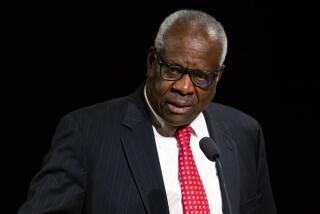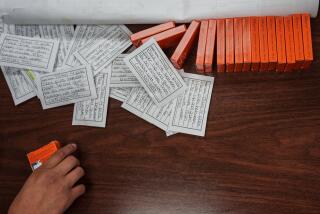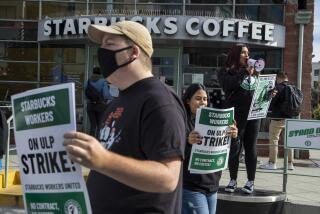Smokers May Sue for Fraud, Justices Rule
SAN FRANCISCO — Diseased smokers in California may sue tobacco companies for fraud and negligence, relying on evidence of misconduct for all but a 10-year period when cigarette makers were protected from lawsuits, the California Supreme Court ruled Monday.
The court’s action paves the way for many new lawsuits against the industry and potential multimillion-dollar awards for victims. Evidence that the industry may have altered tobacco with additives to make it more addictive will be admissible regardless of the industry’s past protection from lawsuits.
Roughly 65 anti-tobacco lawsuits are pending in California. The state high court’s rulings in two cases Monday ensure that the smokers and their heirs in these suits will be able to use a wide range of internal tobacco industry documents from before 1988 that have been deployed with devastating results so far in California.
But the state high court also gave some relief to cigarette makers. The court held that most evidence of the industry’s conduct from 1988 to 1998, when the state’s legislative protections for tobacco companies were in place, cannot be presented to a jury. The tobacco immunity law was repealed in 1998.
The ruling has been long anticipated because three consecutive large awards against cigarette makers have put California in the forefront of the legal war over smoking. The threat from lawsuits by individual California smokers is considered one of the greatest legal problems facing the tobacco industry, along with a racketeering suit by the U.S. Justice Department and a $144.8-billion verdict in a Florida class-action lawsuit that is under appeal.
Daniel U. Smith, who represented smokers in the two cases decided Monday, called the rulings “a major victory for smoking victims in California.” He said smokers will prevail at trial without evidence of the industry’s conduct from 1988 to 1998.
“The mountain of evidence in these cases is from the ‘50s and the ‘60s,” Smith said.
The tobacco industry predicted that Monday’s rulings will lead to new trials in three cases in which California courts have awarded smokers $153 million in verdicts against manufacturers.
Charles A. Blixt, general counsel for R.J. Reynolds Tobacco Co., called the rulings “a victory for fundamental fairness,” because they did not hold the industry responsible for actions taken during the 10 years of immunity.
On a down day on Wall Street, tobacco stocks were up. Shares of Philip Morris Cos., the top cigarette maker, rose $2.29 to $47.50; R.J. Reynolds Tobacco gained $1.54 to $56.14. The favorable market reaction appears to have been based on expectations that the decisions would be even worse for the industry.
Monday’s rulings came in two cases brought by smokers who died of lung cancer. Both cases had been dismissed by trial courts on the grounds that the 1988 immunity law barred such litigation.
The California Supreme Court revived the lawsuits and rejected industry claims that the immunity law also protected the industry for the years before 1988.
“With respect to conduct falling outside the 10-year immunity period, the tobacco companies are not shielded from product liability lawsuits,” wrote Justice Joyce Kennard in Myers vs. Philip Morris Cos., S095213.
The court, on the other hand, rejected plaintiffs’ claims that the 1998 repeal eliminated the industry’s protections for the prior 10-year period.
Betty Jean Myers, the plaintiff, smoked from 1956 until 1997 and died at the age of 59 from lung cancer. A lawsuit being pressed by her children was dismissed in federal district court on a motion by the industry. Her children appealed to the U.S. 9th Circuit Court of Appeals, which asked the California Supreme Court to clarify how the decade of tobacco protection affects pending and future lawsuits.
Justice Carlos Moreno, the sole dissenter in Myers’ case, insisted that the Legislature’s repeal of the immunity law in 1998 was retroactive and wiped out any lingering protection for the tobacco industry.
The broader tort reform law that gave cigarette makers immunity has been dubbed the “Napkin Deal.” A group of powerful elected officials, including then-Assembly Speaker Willie Brown and then-Senate President Pro Tem Bill Lockyer, met with lobbyists from several industries at Frank Fat’s restaurant in Sacramento and scrawled details of the proposed law on a napkin.
Philip C. Bourdette, who represents Myers’ children, predicted they will eventually prevail. “We are now back in court,” he said.
Ronald Olson, who represented Philip Morris in the case, said he also was gratified by the ruling because it will limit the evidence Myers’ family can present. “Clearly this narrowed the scope of the litigation,” he said.
In a companion case, Naegele vs. R.J. Reynolds Tobacco Co., S090420, the California Supreme Court ruled that the industry is not completely protected from evidence of its conduct during the 10 years it enjoyed immunity. If the industry used additives to make smoking more addictive, that evidence can be presented regardless of time, the court said.
The Naegele case was brought by Edwin Brigham, who smoked cigarettes from 1950 until he was diagnosed with lung cancer in 1996. He sued R.J. Reynolds Tobacco Co. and Brown & Williamson Tobacco Corp. for negligence and fraud. When Brigham died, the suit was carried on by Joseph Naegele, the trustee for the estate.
A state trial court dismissed his suit, and a Court of Appeal in San Francisco upheld that decision. The Supreme Court ruled that even during the 10-year period, immunity was not absolute.
“It does not extend to allegations that tobacco companies, in the manufacture of cigarettes, used additives that exposed smokers to dangers beyond those commonly known to be associated with cigarette smoking,” Kennard wrote in the 5-2 decision.
She stressed that the immunity law “does not shield a tobacco company from liability for injuries or deaths caused by something not inherent in the product itself.” Plaintiffs say some cigarette manufacturers have added ammonia to tobacco to make cigarettes more addictive, a charge cigarette makers deny.
Justice Kathryn Mickle Werdegar, joined by Moreno, said in a partial concurrence and dissent that the court should have limited the impact of the immunity law even further to allow fraud claims based on high-nicotine tobacco.
Brigham’s case will return to the state Court of Appeal, which must follow the state high court’s lead.
H. Joseph Escher III, who represents R. J. Reynolds in the case, said his client was “very happy” with the results. “They can’t say that tobacco companies are liable for anything they did during those 10 years, except the notion that we adulterated the products to make them more dangerous,” Escher said, “which they will not be able to prove.”
But Madelyn Chaber, who represents Brigham’s family, said there is plenty of evidence against tobacco companies from before 1988. “Anything that happened in that 1988 to 1998 period is merely a sort of continuance of past conduct,” she said.
Lawyers could appeal to the U.S. Supreme Court on several constitutional issues, but none suggested Monday that they were considering that.
Defense attorneys will use Monday’s rulings to argue that three multimillion-dollar verdicts against the tobacco industry since 1998 should be overturned because juries based their decisions at least in part on evidence of tobacco company conduct from 1988 to 1998.
For example, plaintiffs introduced a 1994 videotape of tobacco CEOs testifying under oath before Congress that they did not believe nicotine was addictive.
Plaintiff lawyers say, however, that the overwhelming evidence in those trials was about the industry’s actions from the 1950s to the 1980s, when tobacco companies aggressively disputed evidence of the harms of smoking.
In March 1999, in the first case tried after the repeal of the immunity law, a San Francisco jury awarded $51.5 million to lung cancer sufferer Patricia Henley. The trial judge later trimmed the award to $26.5 million.
A year later, cancer victim Leslie J. Whiteley won $21.7 million from Philip Morris and R.J. Reynolds.
And last June, a Los Angeles Superior Court jury ordered Philip Morris to pay $5.54 million in compensatory damages and $3 billion in punitive damages to 57-year-old Richard Boeken, who has since died. The trial judge trimmed the punitive damages to $100 million.
Anti-tobacco lawsuits typically allege that cigarette makers could have made safer cigarettes, but failed to, manipulated nicotine delivery systems to sustain the addiction of their customers, and concealed the hazards and addictiveness of their products.
The three smokers’ victories are in various stages of appeal, and William S. Ohlemeyer, vice president and associate general counsel for Philip Morris, said Monday’s rulings provide fresh ammunition in seeking reversals.
“We will now review those cases to determine how the court’s new decision affects those appeals--including, for example, what evidence should have been excluded at trial,” Ohlemeyer said.
But Michael Piuze, who represented Richard Boeken, said he did not believe the verdict will be thrown out as a result of Monday’s rulings, which he called “virtually a total loss” for the industry.
Legal observers said the rulings, by providing a road map for plaintiffs, are likely to trigger more lawsuits. But they cautioned that the new claims may be less than a flood.
For one thing, they noted, California has a one-year statute of limitations for most types of personal injury suits. That means that people diagnosed with smoking-related ailments more than a year ago are ineligible. People who were recently diagnosed, or suffer smoking-related diseases in the future, can sue.
And Chaber, who was the lawyer for Henley and Whiteley and also represented Myers in the appeals, said doing battle with the tobacco industry is still a daunting prospect for many potential plaintiffs and their lawyers.
She cited a case in which tobacco defendants have sought the computer hard drive of a plaintiff “so they can look at every e-mail they ever sent.”
For many potential litigants, “there isn’t the time or the energy or the money to invest in cases that have no chance of settling,” Chaber said.
More to Read
Get the L.A. Times Politics newsletter
Deeply reported insights into legislation, politics and policy from Sacramento, Washington and beyond. In your inbox three times per week.
You may occasionally receive promotional content from the Los Angeles Times.











